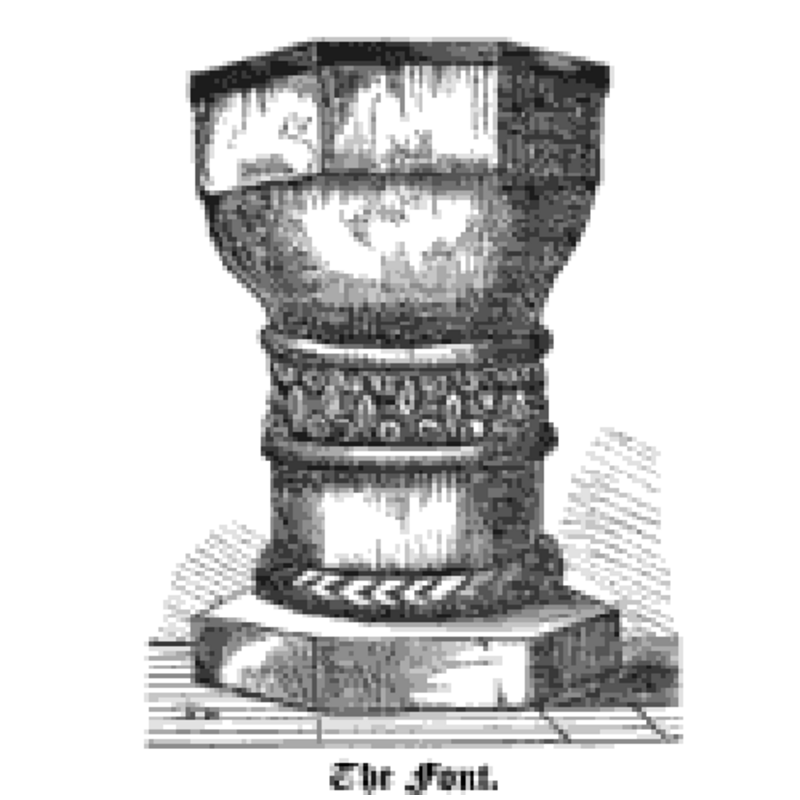Thame

Image copyright © [in the public domain]
PD
Results: 5 records
CR01: design element - motifs - roll moulding - double
LB01: design element - motifs - rope moulding
R01: design element - motifs - moulding - flat moulding
view of font
INFORMATION
FontID: 05956THA
Object Type: Baptismal Font1
Church/Chapel: Parish Church of St. Mary the Virgin
Church Patron Saints: St. Mary the Virgin
Church Location: Church Road, Thame, Oxfordshire, OX9 3AJ
Country Name: England
Location: Oxfordshire, South East
Directions to Site: Located 12 km WSW of Aylesbury down the A418
Ecclesiastic Region: Diocese of Oxford [previously in Dorchester and Lincoln]
Font Location in Church: Inside the church
Century and Period: 12th - 13th century [composite font], Medieval [composite]
Font Notes:
Click to view
A copper engraving of this font, by Frederick Mackenzie (1788-1854), appears in Joseph Skelton’s 'Antiquities of Oxfordshire' (1823). Tymms (1834) comments: "for immersion, singular in design". The Ecclesiastical and Architectural Topography of England: Oxfordshire (1850) notes: "The font is E[arly] E[nglish], round, enriched with foliage." Noted and illustrated in Lee (1883), who describess the font move from the western end of the nave to the centre aisle, as "a great mistake and a great blunder [...] where [...] it efficiently obstructs the carrying of corpses through the western door, on a level with the churchyard, without ascent or descent; it bars the progress both of marriage and funeral processions, and is altogether in its wrong place. The two stone steps upon which it previously stood were removed; the socket of the branch for the 'font-taper' extracted, put aside, and lost; the old oaken lid with which the Font was covered was taken away and never replaced; the drain for the blessed water, when used, to be let off, was of purpose stopped up, so that ever since the period in question the Font has never been filled, but a small crockery dish is apparently used in its stead. The Font is of rare antiquity and interest, carved in close-grained freestone, and probably not less than six hundred and fifty years old. Octagonal in shape as regards the bowl, it now stands exactly three feet and six inches in height. The bowl itself is two feet and a half in diameter, measured from edge to edge, but the hollow circle containing the leaden basin measures only two feet and one inch. On one side the stone is shattered, from which part the fastening which formerly secured the hinge to the cover has evidently been wrenched." Lee (ibid.) notes also several entries in the church-wardens books: in 1455 and 1552, for instance, they note expenditures related to the font and its accutrements. The font is described in Tyrrell-Green (1928) as an octagonal mounted baptismal font of the Norman period ornamented with a rope moulding. In Sherwood & Pevsner (1974): "Made up of fragments. The re-cut octagonal bowl and band of leaf decoration are C13. On the base is C12 cable-moulding. The C17 wooden cover has strapwork cresting and a ball fimial." The font looks very strange and awkward, perhaps from its being a composite object: the basin is octagonal on its upper half, the only decoration being a flat moulding at its upper rim, but the lower half is rounded, curving in at the underbowl to a large centre ring made of a band of foliage between two roll mouldings, then a plain and short cylindrical stem, and a broad rope moulding at the lower end of the base; it is raised on a tiny octagonal plinth.
COORDINATES
UTM: 30U 640129 5735183
MEDIUM AND MEASUREMENTS
Material: stone
Font Shape: octagonal (mounted)
Basin Interior Shape: round
Basin Exterior Shape: octagonal
Drainage Notes: lead-lined [cf. FontNotes]
Rim Thickness: 6.25 cm [calculated]
Diameter (inside rim): 62.5 cm*
Diameter (includes rim): 75 cm*
Font Height (less Plinth): 105 cm*
Notes on Measurements: * [in ft/in in Lee (1883)]
LID INFORMATION
Date: 17th-century?
Material: wood
Notes: [cf. FontNotes]
REFERENCES
Lee, Frederick George, Rev., The History, description, and Antiquities of the Prebendal Church of the Blessed Virgin Mary of Thame, in the County and Diocese of Oxford, [...], London: Printed and published by Mitchell and Hughes, 1883
Parker, John Henry, The Ecclesiastical and architectural topography of England: Oxfordshire, Oxford, London: Published under the sanction of the Central Commitee of the Archaeological Institute of Great Britain and Ireland [by] John Henry Parker, 1850
Pevsner, Nikolaus, Oxfordshire, Harmondsworth: Penguin Books, 1974
Skelton, Joseph, Skelton's engraved illustrations of the principal antiquities of Oxfordshire, from the original drawings of F. Mackenzie, Oxford: J. Skelton, 1823
Tymms, Samuel, Family Topographer, being a compendious account of the antient and present state of the counties of England: vol. IV, Oxford circuit, London: Nichols & Son, 1834
Tyrrell-Green, E., Baptismal Fonts Classified and Illustrated, London: Society for Promoting Christian Knowledge: The Macmillan Co., 1928
